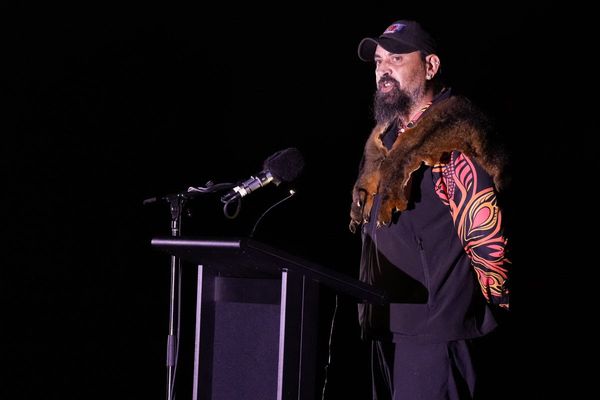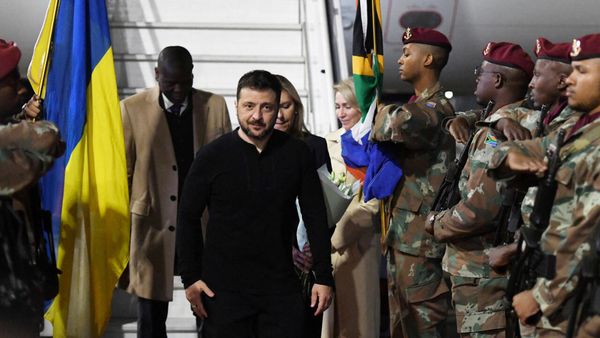
A witness thought to be one of the last people to see Amber Haigh has admitted that he may have estimated the date he saw her after watching a news item on her disappearance, a court has heard.
Army veteran James Arber, who grew up in Boorowa in New South Wales, also confirmed police asked him to wear a wire and talk to Robert and Anne Geeves after he came forward with information in 2021 but he dismissed the idea as “nonsense and a bit weird”.
Robert and Anne Geeves are on trial at the New South Wales supreme court for the murder of Haigh, who was 19 when she vanished without trace from the New South Wales Riverina area in July 2002, leaving behind her five-month-old son fathered by Robert. Both Robert and Anne Geeves have pleaded not guilty.
Giving evidence on Wednesday, Arber told the court that he met Robert Geeves twice when he was a school student, once at the Geeves home in 2000 and once at his grandmother’s house in 2002.
His father, Peter Arber, a panel beater, used to work with Geeves at a vineyard and worked on his car.
James Arber said at the age of 18, he came home from school in 2002 to find Robert Geeves standing in his front yard with Anne Geeves, Haigh and the baby. Arber was introduced to Haigh but every time he spoke to her, Anne or Robert would answer for her, he said.
Robert Geeves told the Arbers they were travelling to Sydney. James Arber said he watched as they left with Robert driving, Anne and the baby in the front seat and Amber in the back seat with two large striped bags “choc-a-block”.
He told the court he later saw them at the Boorowa Mobil service station filling up with fuel but he did not see Haigh in the car.
Arber told the court he came forward after seeing Haigh on a police missing person website in 2021 so he called Crime Stoppers. He said he “did a lot of research” but he did not originally know Geeves’ background.
He originally told police the service station sighting was in May 2002 but he subsequently said it was June 2002.
Asked by the defence whether he had ever told anyone he believed the sighting at his house and at the service station was in June 2002, Arber replied: “I may have, yes”.
Defence then asked whether he got that information from watching A Current Affair, to which Arber replied “yes”.
Arber agreed he had read “heaps of articles”, including that Geeves had “shot a girl in the face and put her in a wheelbarrow and put her in the shed”, Arber said.
Asked by defense counsel whether he thought Robert Geeves was a dangerous man, he said “yes” but that he wasn’t scared of him. Defence also asked about his army record and the fact that he received a medical discharge after serving in Afghanistan.
Arber gave confused evidence on the colour of Geeves’ car, first saying it was blue, then saying he didn’t remember.
Arber’s evidence will continue on Thursday morning.
The court on Wednesday also heard evidence from Leon Henry, who lived with his wife, Daphne, in the unit next door to Haigh in the NSW town of Young. Daphne Henry befriended the young mother and Leon Henry told the court he used to see Robert and Anne Geeves coming and going from the flat.
One day Robert Geeves dropped into Haigh’s flat on his own, Henry said.
“He picked up the bassinet that was in the unit, dropped it over to my place. Said it was his bassinet and Amber was not to have it,” Henry told the court.
He described Haigh as “a proud mum”. “She used to say everything was fine.” Soon after Haigh had the baby, she dropped into the flat to pick up some things and go out to the Geeveses’ Kingsvale home “so Robert and Anne could help her look after the baby”.
“She said she wasn’t capable of doing it on her own,” Henry said.
But after Haigh took the baby to Sydney, Geeves had trouble locating her and the court heard Geeves took the bassinet from the flat and kept it at Henry’s flat.
Haigh later told Henry that “she didn’t want to see him [Geeves] any more”.
“She was getting her locks changed. I wasn’t to let him in,” Henry said.
The last time Henry saw Haigh at the flat was on 2 June 2002.
“The only way I learned Amber had gone missing was when the police knocked on my door and told me,” Henry said.
Haigh was last seen on 5 June 2002. The Geeveses said they drove her that evening from Kingsvale to Campbelltown railway station so she could visit her dying father in hospital, and have not heard from her since.
They told police Haigh willingly left her infant son in their custody.
The Geeveses reported Haigh missing a fortnight later, on 19 June 2002.
The court also heard from Emma Baldock, a counsellor at the Tresillian QEII Family Centre in Canberra.
Haigh attended counselling sessions with Baldock while she stayed at the centre for five days in March 2002 for education and support when the baby was less than two months old.
Baldock told the court she found it difficult to get “a clear story” from Haigh, who had expressed some confusion about her relationship with Robert. The court also heard Robert and Anne Geeves had helped settle the child at night during some visits to the centre.
According to file notes, Haigh was pleased to see the Geeveses when they visited her at the centre.
Asked during re-examination whether Haigh could have cared for the baby with education and experience on her own, Baldock said: “I think in fairness to Amber there would have always been needed to be guiding support.”
She described Haigh as displaying “disorganised attachment”, meaning “the person has not had the ability to form trusting relationships and so they tend to form relationships in a belief and hope that that will provide them with love and security”.
“They can be somewhat indiscriminate and you can see it right from toddlerhood right through into adulthood,” she said.
Haigh’s disappearance baffled the local area after she left behind a five-month-old son who the court has heard she “adored” and “never let out of her sight”.
Haigh’s body has never been found, but a coroner has ruled she died from “homicide or misadventure”.
The prosecution has alleged in court that Haigh – described in court as “very easily misled” – was used by Robert and Anne Geeves as a “surrogate mother” because they wanted another baby.
The court has previously heard the Geeveses had had one child together – a son the same age as Haigh, who had previously dated her – but the couple wanted more children, having subsequently endured three miscarriages and a stillbirth.
“The crown case theory is that it was always the intention of the Geeveses to assume the custody and care of [the child] from Amber, but they knew that to do that, Amber had to be removed from the equation … so, the crown asserts, they killed her,” crown prosecutor Paul Kerr said.
Lawyers for Robert and Anne Geeves have argued the case against the couple – now more than two decades old – is deeply flawed and that “community distaste” at Robert Geeves’ relationship with “a much younger woman with intellectual disabilities” fuelled “gossip and innuendo”.
“Everything they did was viewed through a haze of mistrust and suspicion,” the court has heard.
The judge-alone trial continues in Wagga Wagga.







